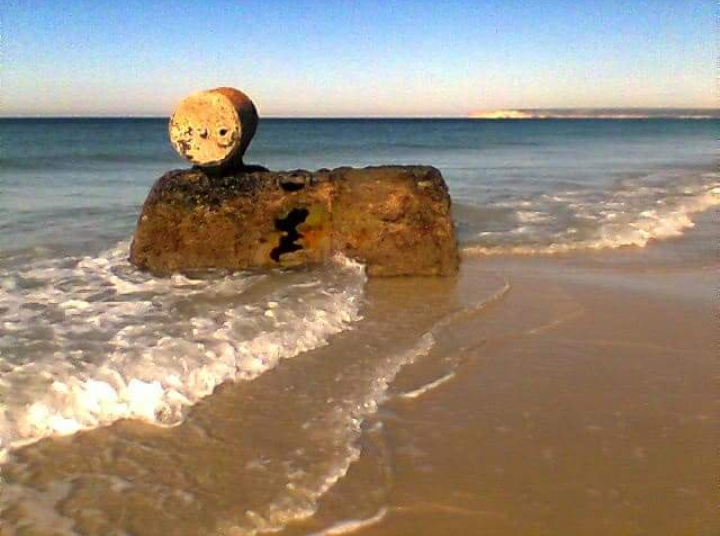"EL VAPOR".
El martes 12 de diciembre de 1.893 encalló en Zahara el "GLADIATOR", matrícula de Glasgow. Varias horas antes había tocado fondo cerca de Tarifa, abriéndose una vía de agua en su interior.
A las 06:40 de ese mismo día, el comandante de la Marina de Cádiz recibió este escueto telegrama:
" Vejer 12 (6,40)- Barba. Vapor inglés Gladiator, Capitán David Kin, procedencia Gibraltar, destino Liverpool, diez y siete hombres, embarrancó en la tarde de hoy playa Zahara; gente y equipajes salvados. Tocó cabezas Tarifa; detalles correo."
Varios días después, concretamente los días 15 y 16 de diciembre de 1893, el periódico "El Imparcial" en su edición de Madrid publicaba las siguientes noticias del Naufragio:
"Acaban de llegar los tripulantes del vapor Gladiator que, como dije ayer, se dirigía desde Gibraltar a Liverpool, con cargamento consistente en 600 cajas de azúcar. Según me ha referido un tripulante, el buque tocó en el bajo las Cabezas, frente a Tarifa. A consecuencia del choque se abrió una gran vía de agua. A pesar de esto, continuaron navegando más de 15 millas pero al ver que el buque empezaba a sumergirse, dispuso el capitán que se embarrancase en la playa de Zahara, como así se hizo.
Enseguida el capitán dispuso lo necesario para que el buque fuese abandonado. Cuando se disponían a cumplir las órdenes del capitán , llegó el ayudante de marina para prestar los auxilios necesarios. Uno de los botes en que iban varios tripulantes fue echado a pique por un golpe de mar. También estuvo en peligro de zozobrar otro bote que acudió en auxilio, como el anterior, y que salvó tres tripulantes. Del buque solo pudo extraerse la documentación y el equipaje.
El Gladiator se partió completamente durante la última madrugada. No es posible salvar nada del cargamento, que valía cien mil duros (500.000 pesetas = 3.000 Euros). El buque costó cuarenta mil, pesaba mil toneladas y fue construido hace treinta años en Inglaterra y estaba asegurado. Los náufragos regresarán inmediatamente a Inglaterra. con los náufragos ha venido a Cádiz el naviero Sr. Haines, que salió ayer con objeto de ver si podría salvar al Gladiator."
No hubo que lamentar desgracias personales, pues queda constancia que tanto el capitán del vapor David Kin, com los restantes miembros de la tripulación fueron trasladados desde Zahara al puerto de Cádiz en dos carruajes, donde embarcaron con destino a Liverpool. Los gastos corrieron por parte del gobierno británico. Los intentos por reflotar el barco fueron en vano.
Hoy es uno de los símbolos más importantes y reconocidos de Zahara de los atunes.
"THE STEAMSHIP".
On Tuesday, December 12th 1893, the "Gladiator", registered in Glasgow, ran aground in Zahara. Several hours earlier it had run aground near Tarifa, opening up a leak in its interior.
At 06:40 that same day, the commander of the Cádiz Navy received this brief telegram:
"Vejer 12 (6.40)- Barba. English steamship Gladiator, Captain David Kin, from Gibraltar, destination Liverpool, seventeen men, ran aground this afternoon on Zahara beach; people and luggage saved. Headed for Tarifa; mailing details ".
Several days later, specifically on December 15th and 16th 1893, the newspaper "El Imparcial" in its Madrid edition published the following news of the shipwreck:
"The crew of the steamer Gladiator which, as I said yesterday, was bound from Gibraltar to Liverpool, with cargo consisting of 600 boxes of sugar, have just arrived. According to what a member of the crew has told me, the vessel struck the Bajo las Cabezas, off Tarifa. As a result of the collision, a large waterway opened up. Despite this, they continued sailing for more than 15 miles, but when they saw that the ship was beginning to submerge, the captain ordered it to run aground on the beach of Zahara, which it did.
The captain immediately arranged for the ship to be abandoned. When they were about to carry out the captain's orders, the naval aide arrived to provide the necessary aid. One of the boats carrying several crew members was capsized by a blow from the sea. Another boat, which came to the rescue and saved three crew members, was also in danger of capsizing, like the previous one. Only documentation and luggage could be removed from the vessel.
The Gladiator broke down completely in the early hours of the morning. It was not possible to salvage any of the cargo, which was worth 100,000 duros (500,000 pesetas = 3,000 Euros). The ship cost forty thousand, weighed one thousand tons, was built thirty years ago in England and was insured. The castaways will return immediately to England. The shipowner Mr. Haines came to Cadiz with the castaways, who left yesterday to see if he could save the Gladiator".
No personal misfortune was to be regretted, as it is recorded that both the captain of the steamer David Kin and the remaining members of the crew were taken from Zahara to the port of Cadiz in two carriages, where they embarked for Liverpool. The expenses were paid by the British government. The attempts to refloat the ship were in vain.
Nowadays “The Steamship” (Known as “El Vapor”) is one of the most important and recognised symbols of Zahara de los Atunes.
